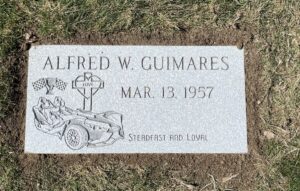
Flat Monuments Vs Upright Monuments – Which Should You Choose?
Monuments are important in commemorating an event or a person and can come in different styles and sizes. Although many people attach monuments to serving funerary purposes, they also serve as a structure that tells of political, social, architectural, or historical achievements and milestones.
Whether to choose between flat Monuments and upright monuments has always been a cause for debate. While they serve the same purposes, they are appropriate at different places and times.
After perusing this piece, you’ll understand where you can apply each type of monument and when you should choose each one.
Where to Apply Flat Monuments
Flat Monuments are usually made from granite or bronze, and they flush with a surface – ground or building. They are used on buildings, sculptural foundations, historical sites, and burial grounds.
Flat Monuments on Burial Grounds
 When you lose a loved one, you want to commemorate their life and death with a structure that depicts the quality of life that they have, but certain factors can limit how much you can express.
When you lose a loved one, you want to commemorate their life and death with a structure that depicts the quality of life that they have, but certain factors can limit how much you can express.
Flat monuments, also called flat markers, are especially suitable when you’re looking to take as little space as possible. They are relatively cheaper than upright monuments and can be used for multiple graves. However, they’re not suitable for viewing from a distance.
Flat monuments sometimes require a foundation to set on, or they can be set in the ground, hence the name, grass-level headstones.
Flat Monuments on Buildings
Some buildings hold architectural history and their story can only be accurately told when there’s an engraving on a granite or bronze plate that is on a part of the building that tells it.
Flat monuments on a building usually tell of the date the building was built, the reason for the existence of the building, the contributors to the success of the construction, and many more. They can also show the different levels of a building and their purposes.
Flat monuments on buildings are usually set against a wall so that they’re flush with it. They can come in different sizes, depending on how much message the monument carries.
Flat Monuments of Sculpture Foundations
 Historical sculptures need a place for descriptions surrounding the reason for their construction and the story they tell. Sculptures are usually set on a raised foundation. These foundations are suitable places to have flat markers that tell the specific story of each sculpture.
Historical sculptures need a place for descriptions surrounding the reason for their construction and the story they tell. Sculptures are usually set on a raised foundation. These foundations are suitable places to have flat markers that tell the specific story of each sculpture.
Depending on the shape of the sculpture’s foundation, flat monuments can be placed on the vertical side of the foundation walls or on its top, directly beneath the sculpture.
Where to Apply Upright Monuments
Upright monuments, unlike flat monuments, use more vertical space and also vary in size and design. They appear to be more extravagant, and they can be made from granite, stainless steel, or marble. They are easily seen from a distance.
Upright Monuments on Burial Grounds
 In an effort to give your lost loved one a befitting burial, an upright monument may be the way to go. They are large enough to allow you to include as many messages as you’d like to include on their gravestones.
In an effort to give your lost loved one a befitting burial, an upright monument may be the way to go. They are large enough to allow you to include as many messages as you’d like to include on their gravestones.
Upright monuments on burial grounds also help relatives and friends to locate their loved one’s grave faster, as they can easily spot it from afar. They are available in different sizes and designs, and they use up less ground space compared to flat monuments.
However, upright monuments require a strong base for support and they are considerably costlier than flat monuments.
Upright Monuments on Building Grounds
Large grounds with different buildings may require an upright monument to direct guests to the right building they’ve come to visit. Upright monuments for such building grounds carry messages that show the direction of each building and how to distinguish one from the other. They are usually large enough to contain all the necessary messages and strategically placed for all to see.
Upright monuments for building grounds also require a strong base for support against the wind. They can also be used to tell the story of a building and how the grounds came about. They are excellent for passing important information about a large building across to visitors of the building.
Upright Monuments on Historical Grounds
Flat monuments may be inadequate in size to tell the story of a place. Therefore, using an upright monument to carry all the necessary historical information about a place will be preferable in such cases.
Historical details about the acquisition of a site, the construction of the different structures on it, and how it has developed to become an important historical landmark, are some of the messages an upright monument on historical grounds can hold.
Factors that Should inform your Monument Choice
While upright monuments and flat markers can perform the same functions, you’ll be better served by one than the other in certain conditions. Some of the factors you should consider before making a choice between a flat monument or an upright monument include:
Volume of Messages
The volume of messages you have to pass across to the visitors of a site is an important influencer on whether you should choose a flat monument or an upright monument.
Generally, upright monuments take more messages than flat monuments. However, because they vary in size, you can also have a flat monument that can take as much message as some upright monuments.
Visibility
The messages, or some parts of them, on an upright monument are meant to be visible from a distance. The size of upright monuments makes this possible as letterings are more prominent and more visible. However, flat monuments require that observers are really close to the flat markers before they can see the messages they hold.
If you need a monument that allows better visibility, an upright monument is a right choice. However, if visibility from a distance doesn’t matter, a flat monument will do.
Design and Accessories
Due to the size of flat monuments, you’ll have limited designs and accessories to choose from. However, upright monuments have more designs and accessories you can choose from.
Price
Considering the design, accessories, and visibility differences that each monument type offers, you can expect them to differ in price.
Upright monuments are costlier than flat monuments. If all other factors are the same, and your budget isn’t suitable for getting an upright monument, a flat monument will work.
Final Thought
At the mention of flat or upright monuments, many think of graves and tombstones. Whereas you can use these monuments for historical and architectural markers. Whatever purpose you may need a monument for, Leominster Monument is the right place to get quality and the best monument designs.
